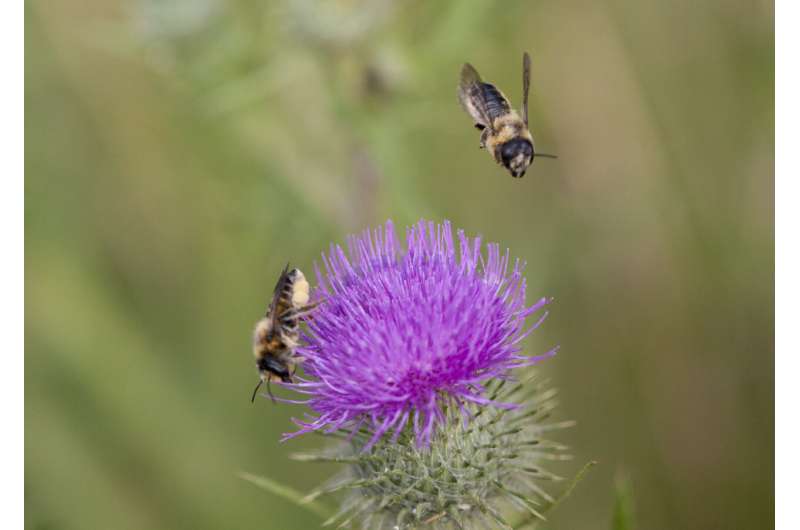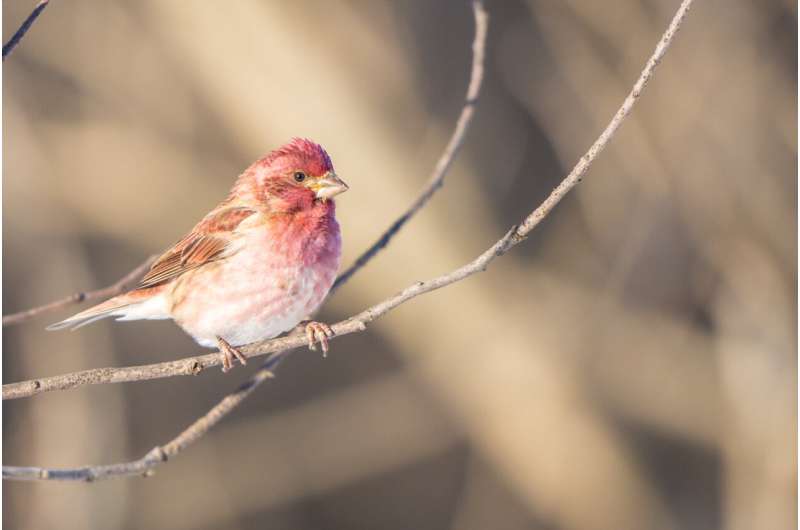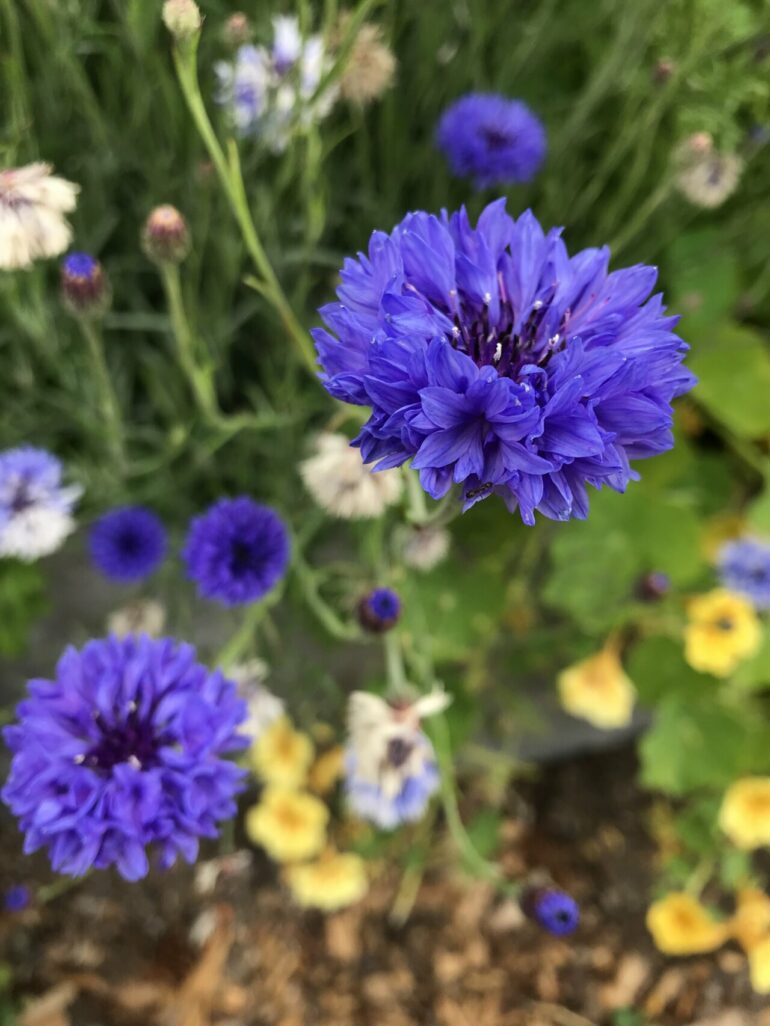Urban gardens can be hotspots for biodiversity in cities, but little is known about what drives the biodiversity of species existing at the smallest frequencies, or rare biodiversity. Rare plant species in urban gardens attract rare bee and bird species, according to a Dartmouth-led study examining urban garden sites in northern California. The results, published in Ecological Applications, show that women, older gardeners and those who live near the gardens tend to curate more rare plants.
“There appears to be a cascading effect of people planting uncommon species on the accumulation of other uncommon bee and bird species,” says lead author Theresa Ong, an assistant professor of environmental studies at Dartmouth.
Over 50% of the plants observed in the urban gardens were rare. “This means that people are planting a great variety of uncommon plants. What we found, too, is that what is rare in an urban garden can be quite common elsewhere and is not necessarily how we would define rarity in less managed systems,” says Ong. “In less managed systems, rare species are often those at greatest risk of extinction.” She notes that in urban gardens, rare organisms may indeed be at higher risk of extinction, but they could also be simply less adapted to the urban environment, or in the case of plants, less popular to grow. “Rare status could be a sign that urban gardens are acting as an important conservation habitat for rare species in cities but could also foreshadow what’s to come for the future of the species,” says Ong.
The purple finch (Haemorhous purpureus) for example, was one rare bird observed in the urban gardens that were part of the study but is considered a fairly common species elsewhere. It is listed a species of least concern in the IUCN Red List of Threatened Species. Ong says, “Their rare status in urban gardens could be a cause for concern if it indicates that their populations are declining. However, it could also be that urban gardens are providing more habitat such as tree cover for purple finches and other birds that cities otherwise lack.”
The research was based on fieldwork from 18 community gardens in the counties of Santa Clara, Santa Cruz and Monterey, California. The urban gardens vary by age, local habitat, landscape context (i.e. ground cover, forest canopy cover, etc.), and socioeconomic demographics of the gardeners. All of the gardens use organic gardening practices where pesticides and insecticides are prohibited.
The team collected data from the urban garden sites over two summers in 2015 and 2017, from May to September. Plant, bee and bird data were obtained in 2015 and urban gardener data were collected two years later. Each of the organisms were sampled through a different method depending on the organism.

Leaf cutting bees (Megachile apicalis) and thistle (Cirsium sp.). © Malcolm Bowey
For plant data, the researchers visited the urban gardens and took random samples, including in the garden plots and surrounding walkways, noting the plants that were cultivated, as well as the weeds and other vegetation present. Plants were measured and classified into either crop or ornamental species and cultivars. Ornamental plants are those that are not cultivated for consumption but for aesthetic reasons, primarily. For bird data, all birds that were either seen or heard were documented, as researchers stood in the center of each garden for 10 minutes. For bee data, bees were caught using pan traps elevated off the ground and aerial nets and were identified later to species level. Researchers also directly asked gardeners what plants they cultivated in the gardens.
Using the field data on plants, bees and birds, the team modeled the correlation between gardener demographic information, the rare plants grown by the gardeners, and the rarity of bird and bee species.
A plant, bee or bird species was only considered “rare” if it appeared in one of the 18 urban gardens or in 2 of the 185 gardener survey responses. Of the 295 total plants observed, over half the plants were rare, with 159 plants representing 156 distinct species.

Purple finch (Haemorhous purpureus) at Miami University Bird Blind, Oxford, Ohio. © Andrew Cannizzaro (CC x 2.0)
“Taro (Colocasia esculenta), was one of the rare plants found in the urban gardens but is not of conservation concern, primarily, because it’s cultivated,” says Ong. “It’s a traditional crop planted in Hawaii and by a lot of Asian cultures. It requires a lot of space to grow and is cooked for its underground corm, much like the tuber of a sweet potato but it’s not a common food grown in California.” Ong suspects that gardeners that grow less common species of crops like taro also cultivate less common habitats for other species, like the heavily watered soils necessary to grow taro well.
Previous research has demonstrated that some rare plants are known to have a specific relationship with rare bees, serving as a host to the other. One such rare plant-bee duo that was observed in the study are “Bachelor’s buttons” (Centaurea sp., a genus of ornamental plants with showy ray flowers belonging to the thistle aster family), and the leafcutting bee (Megachile apicalis), whose female bees cut leaves neatly to make nests for their young, mostly in rotting wood.
One rare bird species that the team encountered was the American kestrel (Falco sparverius). “It’s a small and very cute falcon that is actually the most common and widespread falcon in the continent. Recently its populations have declined, which has been a cause of concern. It’s an important predator of garden pests like mice and voles, so it’s a good sign when it is found in some urban gardens, as it signals that gardens can be managed in a way that provides habitat for a species that is rare in cities,” says Ong. Researchers found that gardens with more canopy cover, meaning more trees, provide better habitat for rare birds.
As for explaining the results as to potentially why rare plants are planted more often by women, older individuals and community members living in close proximity to the urban gardens, Ong says, “Previous research has shown that women tend to display more pro-environmental attitudes, and with age comes wisdom and knowledge of cultivation techniques. But a lot may have to do with people just wanting to take care of their own neighborhood and having pride in that landscape and community, which we find actually encourages more biodiversity in terms of rare species.”
The team’s findings also showed that a lot of the rare plants found in the urban gardens were weeds, so leaving some weeds in your garden could actually be a good thing.
More information:
Theresa W. Ong et al, Rarity begets rarity: Social and environmental drivers of rare organisms in cities, Ecological Applications (2022). DOI: 10.1002/eap.2708
Citation:
Rare plants attract rare bees and birds in urban gardens (2022, July 26)



